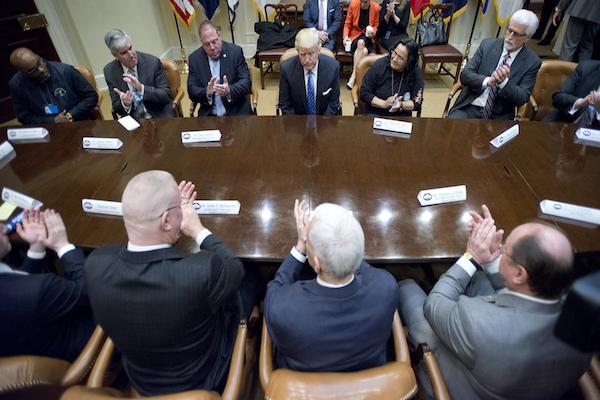Pandering to the Predator: Labor and Energy Under Trump
Donald Trump’s inauguration on January 20th 2017 saw unions and activist groups from numerous social movements take to the streets and declare an all-out war of resistance to both his presidency and his agenda.
As is now clear, some union officials have not only dodged the draft, but have actually joined the opposition. Trump has made it clear that he intends to give full-on support for the further development of fossil fuels. He plans to revive coal, and get behind fracking for shale oil and shale gas. He also plans to approve major infrastructure projects like the Keystone XL and Dakota Access pipelines. This just happens to be a big part of labor’s agenda also, and agenda that has been largely shaped by the North American Building Trades Unions (NABTU).
A Trump-Trades Confederacy?
Leaders of NABTU have not only openly embraced Trump’s energy agenda, they quickly warmed up to Trump himself—and some of his proposed appointees. In a pre-inauguration statement, NABTU praised Trump for nominating former Exxon Mobil CEO Rex Tillermen to be Secretary of State. NABTU said, “We believe he will be a tremendous success,” and praised Tillermen’s “resilient and dynamic grasp of both global and domestic policy issues, and a deep and unyielding sense of patriotism for our great nation.” Of this writing, even prominent Republicans are uncomfortable having someone with a pension plan worth $70 million and who owns $218 million’s worth of company stock become the country’s top diplomat.
In another sign of approval for Trump, the Laborer’s union (LiUNA) criticized the outgoing Administration’s decision to remove offshore areas for future leasing. In one of his final acts as president, Obama thwarted oil and gas industry plans to explore and drill in the Arctic and Atlantic Oceans. Attacking Obama, the union stated, “LIUNA looks forward to working with the Trump Administration to reverse this and other regressive energy policies enacted by the outgoing President.” This from a union that just a few years ago was on the cutting edge of the “green jobs” agenda, an active partner in the Blue-Green Alliance, and one of the first US unions to call on the Obama administration to adopt the science-based emissions reductions targets proposed by the Intergovernmental Panel on Climate Change (IPCC).
Also significant was Trump’s post-inauguration White House meeting with labor leaders on Jan 23rd. Participants included NABTU President Sean McGarvey, LiUNA President Terry O’Sullivan, Sheet Metal workers’ union President Joseph Sellers, Carpenters President Doug McCarron and Mark McManus, president of the Plumbers and Pipefitters. Progressive unions were, it seems, not invited. McGarvey told the New York Times “We have a common bond with the president…We come from the same industry. He understands the value of driving development, moving people to the middle class.”
The Economics of an Arranged Marriage
That NABTU might become little more than an appendage of the Trump administration should hardly come as a surprise. In previous submissions to this column I documented how, in 2009, the Trades formed a formal alliance with the American Petroleum Institute (API) and other fossil fuel interests (which I have affectionately called the Black Blue Alliance). The mission of the alliance was to promote oil and gas development (including its infrastructure) in the US in order to create jobs and advance “energy independence.”
The embrace of Trump’s energy and infrastructure agenda is therefore the logical next step for NABTU, and the implications for the labor movement as a coherent political force are hardly trivial. And if Trump is successful in rolling back regulations on fossil fuels and rescinding climate protection measures, then the planetary implications could over the longer term be devastating.
The Black Blue Alliance, which now has Trump as its figurehead, did not just happen. It needs to be viewed in the context of dramatic changes that have taken place in the energy sector. A decade ago the global price of oil was hovering around $145 per barrel—almost three times higher that today’s prices. The industry had money to burn. But the prices collapsed in 2013, leading to huge layoffs and a dramatic plunge in investment levels. All told, the US lost 122,000 energy and mining jobs in 2015. US fracked shale oil flooded into the global oil market, and OPEC stepped up production in order to drive the price so low that US shale oil would become unprofitable and oil companies would cease production. OPEC’s plan worked to a point, but with global oil and gas consumption continuing to rise for decades to come, and both OPEC and Russian producers having agreed in August 2016 to slow their own output, prices are set to recover and the long-term prospects for US shale oil and gas are therefore good.
This point was underscored in a recent HSBC study that showed how, with global oil demand still growing by 1 million barrels per day every year until 2040 at the earliest, and with 81% of world liquids production is already in decline, the world will need to replace over 4 times the current crude oil output of Saudi Arabia just to keep output flat. HSBC therefore predicted “a strong recovery” for US shale oil production. But with energy demand expected to be flat in the US in the years ahead, coal, gas and oil companies are trying to get their landlocked reserves to mostly coastal refineries and export terminals in order to sell to energy-hungry regions of the world. This ‘rush to the coasts’ is why there have been so many community-led battles in recent years over pipelines, ‘bomb trains’, and coal and gas export terminals and platforms.
Since 2009 unions have actively supported industry plans for the US to become “an energy superpower” that can supply the world. They have got firmly behind industry efforts to export more domestic coal, oil and gas to energy-hungry markets in the Pacific Rim and other regions. Having been conscripted to this effort, the Trades (now NABTU) have been fervent partners with the industry in winning approval for more fracking, more gas and coal export terminals, and more projects like Keystone XL and Dakota Access Pipeline (DAPL). Unions also supported the removal of the export ban on US crude introduced in the 1970s.
In the height of the primaries and with Trump closing in on the Republican nomination, the AFL-CIO, American Federation of Teachers, the National Education Association and the American Federation of State, County and Municipal Employees formed a “Stop Trump” super PAC super PAC with billionaire and hedge fund manager Tom Steyer’s NextGen Climate operation. By launching the PAC, Steyer’s concern about Trump’s open support of climate change denial and his commitment to eradicate climate protection measures appeared to come into political alignment with union concerns about how a Trump presidency and the mortal threat it posed to worker rights and protections. The threat is, of course, now both real and present.
NABTU publicly railed against the AFL-CIO teaming up with Steyer to defeat Trump, and urged the AFL-CIO to pull out. NABTU’s letter to Federation president Richard Trumka made front-page news among sections of the press, some of which routinely ignore covering labor issues. The letter stated, “We do not want any of our members’ financial support for the Federation to be used against them and their economic well being in pursuit of this endeavor.” It also charged, “The AFL-CIO has now officially become infiltrated by financial and political interests that work in direct conflict to many of our members’ — and yes, AFL-CIO dues paying members’ — lives.”

One could argue that NABTU, shooting from the hip, was impervious to the possible impact of a Trump presidency on workers and the environment. But based on the recent past, one could also make a persuasive argument that NABTU’s intentions were based on a clear-eyed assessment of political realities and energy economics. NABTU was simply doing the job it said it would do back in 2009 when it partnered with fossil fuel interests to drive the “energy superpower” agenda. Either way, it is hard to see how such a public exchange—one punctuated by Trump-like accusations—did not contribute in some way to the outcome on November 8th. (In other words, the trajectory of supporting fossil fuel interests in 2009 leads inexorably to a political victory for fossil fuel interests in 2016.)
For progressive labor, energy is now a core issue, and opportunities exist in the Democratic Party and other spaces to reposition labor as a strong advocate for a break with the “energy superpower” agenda. Meanwhile, for NABTU, there is nowhere left to hide. Of this writing, Trump is ready to push for approval of the Keystone XL and Dakota Access Pipelines. This is just the beginning. Unions who side with Trump in these and similar battles will pay a heavy political price. The rank and file and many principled and progressive leaders in the Building Trades and other unions will sooner or later have their say, and the Trump-Trades Confederacy will likely be short lived. Attack dogs normally sleep at the feet of their owners in relative comfort, but they seldom outlive them.




Some national building trades union leaders have volunteered to become a hood ornament on the political bulldozer the Trump cabal will use to destroy a century of labor legislation and worker protections. It is important to note, however, that they do not speak for the entire labor movement or even for all building trades unions. Notable by its absence, for example, was the IBEW, many of whose locals endorsed Bernie Sanders.
With the enactment of a national “right-to-work” (for less) law and end of Davis-Bacon prevailing wage legislation, the very unions who have entered into this devil’s bargain will, along with the rest of organized labor, see their membership and dues revenue dramatically reduced – and along with it, their political and social influence. Those who kissed The Donald’s ring are like cemetery workers who volunteer to dig their own graves.